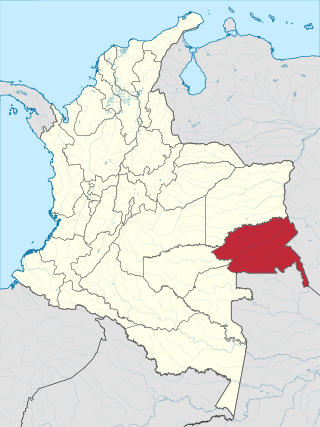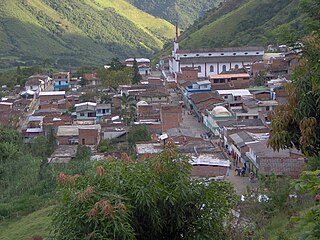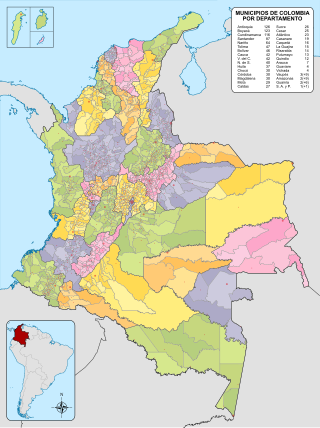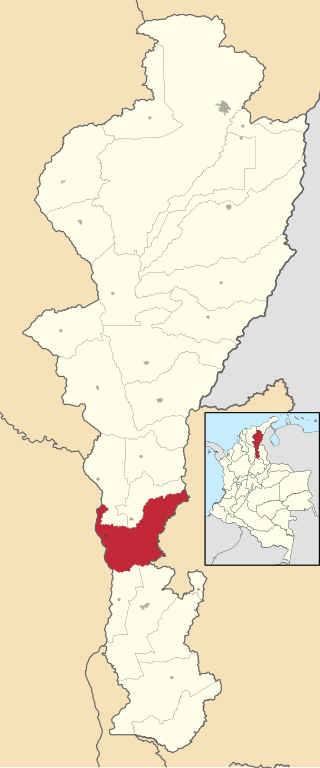
Guainía is a department of Eastern Colombia. It is in the east of the country, bordering Venezuela and Brazil. Its capital is Inírida. In 1963 Guainía was split off from Vaupés department. The northern part and the Inírida River are included in the Orinoco basin; the rest is part of the Amazon basin. The Guaviare River is the main area of colonization; many colonos come from the Colombian Andean zone, most of them from Boyacá. They are followed by the llaneros, people from the Eastern plains (Llanos). The population is mainly composed of Amerindians, and the largest ethnic groups are the Puinaves and the curripacos. There are a total of 24 ethnic groups in the department; many of them speak four Indigenous languages besides Spanish and Portuguese.

Vaupés is a department of Southeastern Colombia in the jungle covered Amazonía Region. It is located in the southeast part of the country, bordering Brazil to the east, the department of Amazonas to the south, Caquetá to the west, and Guaviare, and Guainía to the north; covering a total area of 54,135 km2. Its capital is the town of Mitú. As of 2018, the population was 40,797, making it the least populous department in Colombia.

Valledupar is a city and municipality in northeastern Colombia. It is the capital of Cesar Department. Its name, Valle de Upar, was established in honor of the Amerindian cacique who ruled the valley; Cacique Upar. The city lies between the mountains of the Sierra Nevada de Santa Marta and the Serranía del Perijá to the borders of the Guatapurí and Cesar rivers.

Angelópolis is a town and municipality in Antioquia Department, Colombia. It borders the municipalities of Armenia, Heliconia, and Medellín to the north; La Estrella and Caldas to the east; Amagá to the south; and Titiribí and Armenia to the west. Its municipal seat is 48 kilometers from the city of Medellín, the capital of the department of Antioquia. The municipality has an area of 86 square kilometers.

Arboletes is a town and municipality in the subregion of Urabá in Antioquia Department, Colombia.

Buriticá is a town and municipality in Antioquia Department, Colombia.

Cocorná is a town and municipality in the Colombian department of Antioquia. The population was 14,743 at the 2018 census. It is part of the subregion of Eastern Antioquia.

Liborina is a municipality in Colombia, located in the Western subregion of the Antioquia Department. It borders the municipalities of Sabanalarga, San Andrés de Cuerquia, and San José de la Montaña to the north; San José de la Montaña and Belmira to the east; Santa Fe de Antioquia and Olaya to the south; and Buriticá to the west. Its town center is 80 kilometers via Sopetrán and 77 kilometers via Santa Fe de Antioquia from Medellín, the capital of Antioquia. The municipality covers an area of 217 square kilometers and is connected by road to the municipalities of Sabanalarga, San José de la Montaña, Belmira, Olaya, and Buriticá.

Sonsón is a municipality in the Colombian department of Antioquia. Sonsón is located in Eastern Antioquia. It is one of the seats of the Roman Catholic Diocese of Sonsón–Rionegro. Sonsón celebrates "Las Fiestas Del Maíz"- during the month of August, being the most traditional, historical and representative festival in western Colombia. The population was estimated to be 33,598 in 2020.

San Carlos is a town and municipality in the Colombian department of Antioquia, part of the subregion of Eastern Antioquia. It is called the hydro-electrical capital of Colombia, because it has many dams and it produces much energy. The population was 14,480 at the 2018 census.

The municipalities of Colombia are decentralized subdivisions of the Republic of Colombia. Municipalities make up most of the departments of Colombia with 1,122 municipalities (municipios). Each one of them is led by a mayor (alcalde) elected by popular vote and represents the maximum executive government official at a municipality level under the mandate of the governor of their department which is a representative of all municipalities in the department; municipalities are grouped to form departments.

Floresta is a town and municipality in Boyacá Department, Colombia, part of the Tundama Province, a subregion of Boyacá. Floresta is situated on the Altiplano Cundiboyacense in the Eastern Ranges of the Colombian Andes. It borders Santa Rosa de Viterbo, Cerinza and Betéitiva in the north, in the east Busbanzá and Corrales in the west Santa Rosa de Viterbo and Nobsa in the south.

La Gloria is a municipality and town in the Department of Cesar, northern Colombia by the Magdalena River.

Manaure also known as Balcón del Cesar is a Colombian town and municipality located in the northeastern region of the Cesar Department on the Serranía del Perijá.
Santa Ana is a town and municipality of the Magdalena Department in northern Colombia. Founded in 1751 by José Fernando de Mier y Guerra with the name of Santa Ana de Buena Vista. In 1918 was established as a municipality.

Toledo is a Colombian municipality and town located in the department of North Santander. It is on the border with Boyacá Department and has natural gas development in the township of Gibraltar. In August 2011 the Gibraltar to Bucaramanga gas pipeline was completed.

The Metropolitan Area of the Aburrá Valley is the second most important and populated metropolitan area in Colombia. The region is made up of ten municipalities, Medellín being the most important, largest and the capital city of the Antioquia Department.
Corregimiento is a Spanish term used for country subdivisions for royal administrative purposes, ensuring districts were under crown control as opposed to local elites. A corregimiento was usually headed by a corregidor.
Regional and municipal elections were held on Sunday, 25 October 2015 in Colombia to elect the governors of the 32 departments, deputies to departmental assemblies, mayors of 1,102 municipalities, municipal councillors and aldermen on local administrative boards.
Regional and municipal elections were held on Sunday, 27 October 2019 in Colombia to elect the governors of the 32 departments, deputies to departmental assemblies, mayors of 1,102 municipalities, municipal councillors and aldermen on local administrative boards.
















